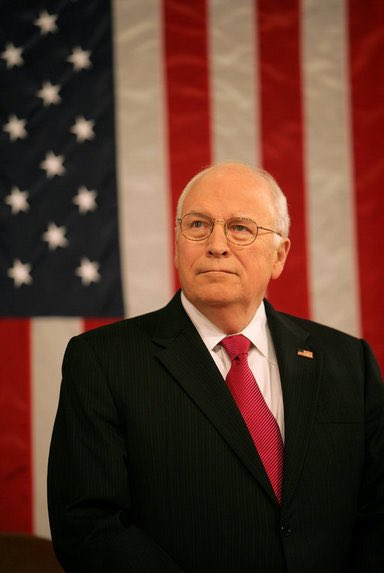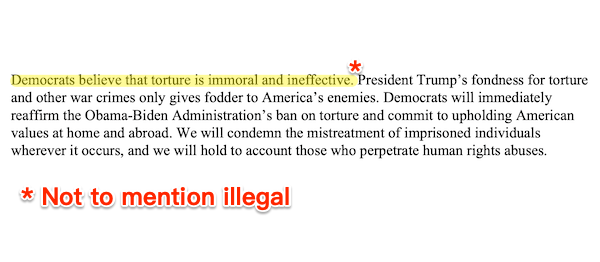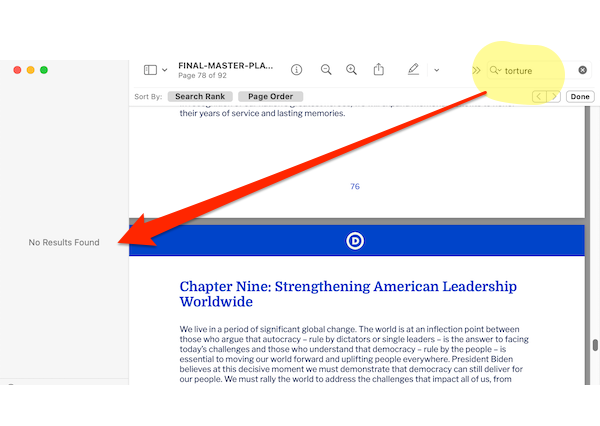By Lambert Strether of Corrente.
Starting with the headline: “Harris ‘honored’ by endorsement from Republican Dick Cheney.” For those who came in late:
On Inauguration Day, January 20, 2001, after Justice Antonin Scalia had selected former Texas Republican Governor, dry drunk, ritually branded Yalie, and Christianist George W. Bush as President in Bush v. Gore (“good for one time only“), the country’s Vice President became former Secretary of Defense and Halliburton CEO Dick Cheney. (After Bush was nominated, he had set up a selection committee for Vice President, chaired by Dick Cheney, and, perhaps surprisingly, ended up picking Cheney himself.) 2018’s Oscar-winning Vice (with Christian Bale as Dick Cheney) despite — or perhaps because of — being a “political satire black comedy” gives a reasonably accurate high-level description of what happened next. From the Summary:
The story of Dick Cheney, an unassuming bureaucratic Washington insider, who quietly wielded immense power as Vice President to George W. Bush, reshaping the country and the globe in ways that are still felt today.
The film returns to the aftermath of the September 11 attacks, as Cheney and Rumsfeld maneuver to initiate and then preside over the US invasions of Afghanistan and Iraq, resulting in the killing of civilians and the torture of prisoners. As the War on Terror mounts, Cheney continues to struggle with persistent heart attacks. The film also covers various events from his vice presidency, including his endorsement of the Unitary executive theory, the Plame affair, the accidental shooting of Harry Whittington, and tensions between the Cheney sisters over same-sex marriage. Cheney’s actions are shown to lead to thousands of deaths and the rise of the Islamic State of Iraq and the Levant, resulting in him receiving record-low approval ratings by the end of the Bush administration.
(Cheney has been described as Bush’s Chief Operating Officer, though Cheney himself concedes his influence waned in Bush’s second term). More:
In this post, for those curious as to why Harris would be “honored” by Cheney’s endorsement, I want to dig a little bit deeper into a few of the more aromatic episodes of Cheney’s tenure, which started just prior to the emergence of the blogosphere. Here’s hoping none of the work done in those days has succumbed to link rot! In order of increasing damage to the country’s institutions and global standing, I will cover the Harry Whittington shooting, Cheney’s adoption of torture as a tool of statecraft, Cheney’s role in fomenting the Iraq War debacle using what we would today call disinformation, and the billions gushing to his former company, Halliburton. All this stuff was difficult and horrid for us “foul-mouthed bloggers of the left” to disentangle at the time, and to see Cheney “honored”… Well, it’s a bit much. Anyhow, here’s a photo of Cheney in case you want to hang it on your kitchen refrigerator or something:

The upward gaze into the brighter future that seems obligatory for Democrats these days…
Cheney Shoots an Old Man in the Face
From Dan Froomkin, back when he was a blogger at WaPo in 2006, with the best headline ever: “Shoots, Hides and Leaves“:
Why isn’t Dick Cheney on TV right now?
The vice president of the United States shoots someone in a hunting accident and rather than immediately come clean to the public, his office keeps it a secret for almost a whole day. Even then, it’s only to confirm a report in a local paper.
“The shooting occurred late Saturday afternoon while Cheney was hunting with Harry Whittington, 78, a prominent Austin lawyer, on the Armstrong Ranch in south Texas. Hearing a covey of birds, Cheney shot at one, not realizing that Whittington had startled the quail and that he was in the line of fire.”
Frank James asks in the Chicago Tribune Washington bureau’s new blog: “How is it that Vice President Cheney can shoot a man, albeit accidentally, on Saturday during a hunting trip and the American public not be informed of it until today? . . .
“When a vice president of the U.S. shoots a man under any circumstance, that is extremely relevant information. What might be the excuse to justify not immediately making the incident public?”
Greg Mitchell writes in Editor and Publisher that “it is not known for certain that Cheney’s office, the White House, or anyone else intended to announce the shooting” had it not been for a call from the local paper.
Why indeed? ‘Tis a mystery! (Fascinatingly, Whittington apologized to Cheney.) Seventeen years later, WaPo follows up with “The thing Harry Whittington refused to lie about” and gets the details of the accident:
When he returned, Whittington was holding an odd object on a hanger. It was an orange safety vBy Lambert Strether of Corrente.est, slit down the side as if someone was in a hurry to remove it. There were brownish splotches of dried blood on it.
For the next few hours, he told me what happened that day — at least what he could remember of it before he’d passed out from his wounds.
Whittington barely knew Cheney; they weren’t “friends” or “hunting buddies,” as news accounts described them. They’d met only a few times before, and had been invited to the ranch by its owner, a mutual friend.
It was late, around 5:30 p.m., and the February light was fading when Cheney fired his errant shot. Whittington said he had been standing slightly downhill and off to Cheney’s right, his body angled in Cheney’s direction.
Though Whittington wouldn’t say so explicitly, his description suggested that Cheney had violated two fundamental safety protocols. First, in wheeling on a bird winging from the scrub, Cheney had fired without checking if his line of fire was clear. Second, he’d aimed downward, ignoring a rule obliging bird hunters to observe “blue sky” before firing..
The aftermath of the shooting was calamitous. The ambulance that carried the unconscious Whittington from the massive ranch to a hospital blew a tire. The trip took close to an hour.
The injuries he’d suffered were far worse than initially reported. The blast hit Whittington with more than 200 pieces of lead birdshot, causing scores of wounds across his eye socket, hairline, neck and torso. One piece lodged near his heart and caused a mild heart attack a few days later. One of his lungs collapsed. Another piece narrowly missed his carotid artery. He nearly bled out.
Whittington recounted these details without anger or sadness. It was an accident, he insisted, and Dick Cheney was a good man.
After talking for nearly 10 hours, I had one last question. Had Cheney ever apologized?
Whittington leveled his gaze at me.
“I’m not going to get into that,” he said after a short pause.
His face was set. I could sense his discomfort.
Harry Whittington wouldn’t lie. He was too gracious for that.
To me, the 24-hour delay reeks. And Cheney’s extraordinary arrogance and sense of privilege isn’t all that might have reeked, either. Perhaps hunters in the readership may with to comment on this. So, “honored.” Really?
Cheney Normalizes Torture
Once again, Froomkin in WaPo from 2008, “White House Torture Advisers“:
Top Bush aides, including Vice President Cheney, micromanaged the torture of terrorist suspects from the White House basement, according to an ABC News report aired last night.
Discussions were so detailed, ABC’s sources said, that some interrogation sessions were virtually choreographed by a White House advisory group. In addition to Cheney, the group included then-national security adviser Condoleezza Rice, then-defense secretary Donald Rumsfeld, then-secretary of state Colin Powell, then-CIA director George Tenet and then-attorney general John Ashcroft.
According to ABC, the CIA briefed the White House group on its plans to use aggressive techniques against Zubaydah and received explicit approval. Zubaydah is one of the three detainees the CIA has since confirmed were subjected to waterboarding, a notorious torture technique that amounts to controlled drowning.
Such techniques were later authorized in a controversial August 2002 Justice Department memo, signed by then head of the Office of Legal Counsel Jay Bybee. ABC reports that the memo “was referred to as the so-called ‘Golden Shield’ for CIA agents, who worried they would be held liable if the harsh interrogations became public.”
Nevertheless, even after the memo was in place, “briefings and meetings in the White House to discuss individual interrogations continued, sources said. Tenet, seeking to protect his agents, regularly sought confirmation from the NSC principals that specific interrogation plans were legal.
And the happy outcome:
Zubaydah, it turns out, was a mentally ill minor functionary, nursed back to health by the FBI, who under CIA torture sent investigators chasing after false leads about al-Qaeda plots on American nuclear plants, water systems, shopping malls, banks and supermarkets.
(It has always been my speculation that Cheney had videos of the torture sessions streamed directly to his office. He always did like his intelligence raw.) Cheney had previously arranged to “legalize” torture by securing guidance from a bent lawyer in the Justice Department’s Office of Legal Counsel, John Yoo
So, (Cheney) established a back channel to John Yoo, the No. 2 man in the Justice Department’s Office of Legal Counsel. Little known to the public, that office tells the president and his subordinates what they can and can’t do under existing law. And with guidance from Cheney and his chief counsel, David Addington, Yoo wrote legal opinions that authorized everything from waterboarding and other harsh interrogation tactics previously considered torture, to domestic surveillance by the National Security Agency without first getting permission from the court set up to approve such surveillance.
(This post won’t even address Bush’s program of warrantless surveillance, which Obama voted to retroactively legalize as a Senator — after promising to filibuster it — and which paved the way for today’s Censorship Industrial Complex).
The Democrat Party platform in 2020 (PDF) rejected torture:

(On illegal, see here.)
The Democrat Party platform in 2024 (PDF) has nothing to say about it:

One might speculate Democrats are now silent on — i.e., accepting of — torture because they wish to attract the (unrepentant, pro-torture) Cheney wing of the Republican Party, or because they don’t want to upset Israel, which tortures routinely. Or perhaps they don’t want to offend Ambassador to Japan Rahm Emmanuel, since the Chicago Police Department’s torture center at Homan Square operated on his watch. Or all three!
On the morality of torture, I think the Stanford Encyclopedia of Philosphy has a good all-round discussion of the topic, comparing and contrasting it to murder:
On the moral wrongness of torture as compared to killing, the following points can be made. First, torture is similar to killing in that both interrupt and render impossible the normal conduct of human life, albeit the latter – but not the former – necessarily forever. But equally during the period a person is being tortured (and in some cases thereafter) the person’s world is almost entirely taken up by extreme pain and their asymmetrical power relationship to the torturer, i.e. the torture victim’s powerlessness. Indeed, given the extreme suffering being experienced and the consequent loss of autonomy, the victim would presumably rather be dead than alive during that period. So, as already noted, torture is a very great evil. However, it does not follow from this that being killed is preferable to being tortured. Nor does it follow that torturing someone is morally worse than killing him….. A second point pertains to the powerlessness of the victims of torture. Dead people necessarily have no autonomy or power; so killing people is an infringement of their right to autonomy as well as their right to life. What of the victims of torture?
The person being tortured is for the duration of the torturing process physically powerless in relation to the torturer. By “physically powerless” two things are meant: the victim is defenceless, i.e., the victim cannot prevent the torturer from torturing the victim, and the victim is unable to attack, and therefore physically harm, the torturer. …
The conclusion to be drawn from these considerations is that torture is not necessarily morally worse than killing (or more undesirable than death), though in many instances it may well be. Killing is an infringement of the right to life and the right to autonomy. Torture is an infringement of the right to autonomy, but not necessarily of the right to life. Moreover, torture is consistent with the retrieval of the victim’s autonomy, whereas killing is not. On the other hand, the period during which the victim is being tortured is surely worse than not being alive during that time, and torture can in principle extend for the duration of the remainder of a person’s life.
As at Gitmo (and I’m so old I remember when Obama promised to close it. Oh well). I don’t want to sidetrack the post into a fruitless discussion of the “ticking bomb” scenario(1). Pragmatically and in the moment, “honored”? We’re honoring torturers now? Really?
Cheney Foments the Iraq War
The post-9/11 2002-2003 run-up to the Iraq War was marked by a disinformation campaign run by the White House Iraq Group (WHIG), which orchestrated planting stories in the press (which we poor bloggers played whack-a-mole with, with great success, but with no effect on outcomes). Cheney didn’t chair the WHIG, but was above it on the masthead, and propagated its disinformation. From the Atlantic (2011), “Remembering Why Americans Loathe Dick Cheney“:
President Bush bears ultimate responsibility for the Iraq War, as do the members of Congress who voted for it. But Dick Cheney’s role in the run-up to war was uniquely irresponsible and mendacious. And after the invasion, he contributed to the early dysfunction on the ground. Even Iraq War supporters should rue his involvement.
The most succinct statement of his misdeeds comes from “The People v. Richard Cheney,” a 2007 article by Wil S. Hylton. The piece recounts how Cheney undercut the CIA by instructing subordinates in that agency to stovepipe raw intelligence directly to his office. He also worked with Donald Rumsfeld to establish an alternative intelligence agency within the Pentagon. Both of these actions directly contributed to the faulty information that informed the decision to go to war.
Hylton then lays out his most powerful argument:
(1) During the several months preceding the March 2003 invasion of Iraq, and thereafter, the vice president became aware that no certain evidence existed of weapons of mass destruction in Iraq, a fact articulated in several official documents, including: (a) A report by the Pentagon’s Defense Intelligence Agency, concluding that “there is no reliable information on whether Iraq is producing and stockpiling chemical weapons, or where Iraq has—or will—establish its chemical warfare agent production facilities.” (b) A National Intelligence Estimate, compiled by the nation’s intelligence agencies, admitting to “little specific information” about chemical weapons in Iraq. (c) A later section of the same NIE, admitting “low confidence” that Saddam Hussein “would engage in clandestine attacks against the U.S. Homeland,” and equally “low confidence” that he would “share chemical or biological weapons with al-Qa’ida.” (d) An addendum by the State Department’s Bureau of Intelligence and Research, asserting that Hussein’s quest for yellowcake uranium in Africa was “highly dubious” and that his acquisition of certain machine parts, considered by some to be evidence of a nuclear program, were “not clearly linked to a nuclear end use.” (e) A report by the United States Department of Energy, stating that the machinery in question was “poorly suited” for nuclear use.
(2) Despite these questions and uncertainties, and having full awareness of them, the vice president nevertheless proceeded to misrepresent the facts in his public statements, claiming that there was no doubt about the existence of chemical and biological weapons in Iraq and that a full-scale nuclear program was known to exist, including: (a) March 17, 2002: “We know they have biological and chemical weapons.” (b) March 19, 2002: “We know they are pursuing nuclear weapons.” (c) March 24, 2002: “He is actively pursuing nuclear weapons.” (d) May 19, 2002: “We know he’s got chemical and biological … we know he’s working on nuclear.” (e) August 26, 2002: “We now know that Saddam has resumed his efforts to acquire nuclear weapons … Simply stated, there is no doubt that Saddam Hussein now has weapons of mass destruction. There is no doubt that he is amassing them to use against our friends, against our allies, and against us.” (f) March 16, 2003: “We believe he has, in fact, reconstituted nuclear weapons.”
(3) At the same time, despite overwhelming skepticism within the government of a link between Iraq and Al Qaeda—resulting in the conclusion of the 9/11 Commission that “no credible evidence” for such a link existed, and the CIA’s determination that Hussein “did not have a relationship” with Al Qaeda—the vice president continued to insist that the relationship had been confirmed, including: (a) December 2, 2002: “His regime has had high-level contacts with Al Qaeda going back a decade and has provided training to Al Qaeda terrorists.” (b) January 30, 2003: “His regime aids and protects terrorists, including members of Al Qaeda. He could decide secretly to provide weapons of mass destruction to terrorists for use against us.” (c) March 16, 2003: “We know that he has a long-standing relationship with various terrorist groups, including the Al Qaeda organization.” (d) September 14, 2003: “We learned more and more that there was a relationship between Iraq and Al Qaeda that stretched back through most of the decade of the ’90s, that it involved training, for example, on biological weapons and chemical weapons.” (e) October 10, 2003: “He also had an established relationship with Al Qaeda—providing training to Al Qaeda members in areas of poisons, gases, and conventional bombs.” (f) January 9, 2004: “Al Qaeda and the Iraqi intelligence services … have worked together on a number of occasions.” (g) January 22, 2004: “There’s overwhelming evidence that there was a connection between Al Qaeda and the Iraqi government” (h) June 18, 2004: “There clearly was a relationship. It’s been testified to. The evidence is overwhelming.”
The piece also charges that “as the war devolved into occupation, the vice president again sabotaged the democratic system, developing back channels into the Coalition Provisional Authority, a body not under his purview, to remove some of the most effective staff and replace them with his own loyal supplicants—undercutting America’s best effort at war in order to expand his own power.”
And that’s before we get to PNAC, Curveball, the aluminum tubes… See the timeline: “Lie by Lie: A Timeline of How We Got Into Iraq.” Cheney was up to his eyeballs in all of it. Why would anyone feel “honored” by the endorsement of such a person?
Cheney Hands Billions of Federal Dollars to His Former Firm, Halliburton
This charming old-school blog from an anonymous computer scientist at Cornell has a fine timeline:
2. Early 1990 to 1993. Cheney, as Secretary of Defense, commissions Halliburton to do a classified (secret) study concerning replacing the U.S. military’s logistics by work done by private companies. Halliburton says, yes, a company can do the work. In August 1992, with essentially no bidding, Halliburton is selected by the US Army Corps of Engineers to do all work needed to support the military for the next five years! Thereafter, Halliburton (or its subsidiary KBR) and its military logistics business escalated rapidly. In the ten years thereafter revenues totaled $2.5 billion.
3. 1995-2000. Cheney is CEO of Halliburton….
9. December 2001. KBR (Halliburton subsidiary) is granted an open-ended contract for Army troops supply and Navy construction, wherever U.S. troops go, for the next 10 years (so far, Afghanistan, the Philippines, Yemen, Iraq). This unique contract has no ceiling on cost. KBR is reimbursed for every dollar spent plus a base fee of 1 percent, which guarantees profit. Plus, they can get a bonus as a percentage of company costs.
As TruthDig wrote (2018), “The Blurred Line Between War and Business“:
In 2009, Rand Paul called out Dick Cheney for supporting the invasion of Iraq to benefit his former company, Halliburton, claiming that Halliburton had received a billion-dollar no-bid contract. KBR, or Kellogg Brown & Root, a subsidiary of Halliburton, was neck-deep in military contracts with the United States government, under a no-bid LOGCAP III (Logistics Civil Augmentation Program) agreement, a contingency-based contract invoked at the convenience of the Army. Let’s not forget that the official narrative of weapons of mass destruction was the lie sold to the American people to justify an oligarchical class growing wealthier through creating war.
In November 2002, a $7 billion LOGCAP contract was given to KBR for extinguishing oil well fires in Iraq. In 2003, the Army Corps of Engineers awarded a public bid contract with a maximum value of $1.2 billion to KBR to continue repairing the oil infrastructure in southern Iraq. In 2004, the Army Corps handed KBR yet another contract, with the value of $1.5 billion, to cover engineering services in the U.S. Central Command’s area of operations in Iraq and Afghanistan. The contract had a $500 million ceiling for the first year and four one-year options, each with an annual ceiling of $250 million. In 2004, KBR received more orders under the LOGCAP contract for work in Afghanistan, which added up to $489 million. And then there is the $400 million in payments KBR made in subcontracting private securities services like Blackwater in Iraq.
In 2004, the public was made aware of Halliburton’s monopoly on billions of dollars in Iraq contracts and in the accumulation of tremendous influence over state matters. Or as Rand warned: the dangerous powers given to large corporations when they “get so big that they can actually be directing policy.” The funneling of vast fortunes to KBR was an egregious problem the government ignored. Major media also gave a pass to these contracts, with no questions asked about the larger structures within government that made this all possible.
In total, $138 billion was awarded in federal funds to private contractors for the Iraq War, with Halliburton receiving more than $39.5 billion of the federal contracts related to the Iraq military invasion and occupation between 2003 and 2013.
Back in 2004, Democrat loser John Kerry called out Cheney in the following terms. From the New York Times:
At a community center in Albuquerque on Sept. 17, Mr. Kerry declared: “Dick Cheney’s old company Halliburton has profited from the mess in Iraq at the expense of American troops and taxpayers. While Halliburton has been engaging in massive overcharging and wasteful practices under this no-bid contract, Dick Cheney has continued to receive compensation from his former company.”
But:
Mr. Cheney’s critics concede that there is no concrete evidence that he has pulled any strings on Halliburton’s behalf.
I think both Kerry and the Times have got hold of the wrong end of the stick. What the timeline I led with implies is that Cheney “set the table” as Defense Secretary for private contractors to make enormous profits from war, then arranged for compensatoin (deferred and otherwise) from one of those contractors, and then “furnished the war” as Vice President (which besides economic capital, surely gained him enormous social capital as well). Why would Cheney’s endorsement be “an honor?” It’s like being endorsed by Tony Soprano after a successful bust-out.
Conclusion
I didn’t even get to the Energy Task Force. Sorry.
Dick Cheney is a torturer, a lying weasel, and corrupt to the bone. (Plus, he’s bad with a gun.) He’s everything that we innocent bloggers, back in 2003, thought that Republicans were, and that Democrats could never be. Cheney is certainly far worse than Trump, and arguably worse than Obama (I’m not sure how to weigh rebooting the financial system after the Great Financial Crash vs. the wars in Iraq and Afghanistan). As those peaceniks over that the Babylon Bee put it: “‘Never Has America Faced A Greater Threat Than Donald Trump,’ Says Guy Who Started Two Wars And Shot A Dude In The Face.” Yet here we are. Democrats are all aflutter:
NEW: The entire Cheney family is voting for Kamala Harris.
RETWEET if you stand with the Cheneys against Donald Trump! pic.twitter.com/w5jNt3YxRU
— Protect Kamala Harris ✊ (@DisavowTrump20) September 6, 2024
(Ah, “stand with,” no less focus-grouped than “fighting for.”) The Democrats are even hoping for a Bush endorsement:
Hello? Isn’t there something you need to say? Everyone is waiting… pic.twitter.com/8Is8qjKBsn
— Claude Taylor (@TrueFactsStated) September 7, 2024
I remain baffled at the use of the word “honored.” How could anyone feel “honored” by the endorsement of such a person? Honor: “honesty, fairness, or integrity in one’s beliefs and actions.” Though I suppose it depends on what your beliefs, if any, actually are. Hamilton Nolan writes:
I believe Dick Cheney’s own explanation that “We have a duty to put country above partisanship to defend our Constitution. That is why I will be casting my vote for Vice President Kamala Harris.” Before you scoff, please allow me to explain. Dick Cheney is one of America’s best living representations of the fluidity of establishment power. Congressional staffer, White House staffer, presidential assistant, White House Chief of Staff, Congressman, Secretary of Defense, corporate CEO, vice president. Dick Cheney is not so much “a Republican” as he is “a man in power.” He ascended the ranks of government power in a friendly administration and then when the administration was gone he got elected to Congress and then he leveled up in another friendly administration and then when that was gone he slid over to running a major corporation that was wholly intertwined with the United States government and finally he leveled up into the White House by standing behind a more likable patsy who he could control.
All of us who vote for Democrats need to understand what we are getting. Our feeling of moral superiority on domestic policy—we are the ones against racism and poverty! We are the ones who protect women!—is at all times floating atop an unmentioned sea of weapons pointed at millions of less powerful people outside of our own borders.
Even among Democrats, the baseline assumption that America must have enough guns to exert our will on the entire world is not questioned. Kamala Harris may push for paid family leave, but she is not going to dismantle the United States intelligence agencies.
It’s not that Donald Trump has any ideological opposition to this commitment, which the Republicans have always embraced with relish. It’s just that he’s insane (disagree) and an unpredictable egomaniac (agree) and therefore cannot be counted on to fulfill his role on this matter (hard agree). Trump has found himself in a feud with America’s intelligence agencies strictly out of personal vanity and prickliness. He is the sort of man who might undermine the CIA or fuck up the Army’s plans for the stupidest, most childish reasons imaginable. This possibility is more than the sort of people who live in that world can tolerate. . And so Dick Cheney and the men like him will support Kamala Harris.
Yes, but honor?!
NOTES
(1) In the cases we are discussing, what gives the ticking bomb scenario an aura of credibility is the presence of the State (surely privatized torture is never, ever moral). But what that means is that there is always a torturer, and always an order-giver. I think the default setting for the order-giver is that they are power-crazed fools, for whom our system is optimized. If all state systems are similarly and inherently so optimized, then torture can never be moral, not even under the most exigent circumstances, because no order-giver can rightly treat the circumstances as known (see Zubaydah above).
APPENDIX Cheney’s Endorsement Statement
Cheney’s statement:
VP Dick Cheney’s official endorsement of VP Harris#RepublicansForHarris pic.twitter.com/IUqdXfM0O7
— Republicans for Harris (@RepsForHarris) September 6, 2024






